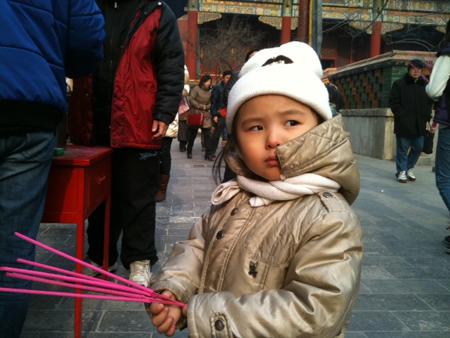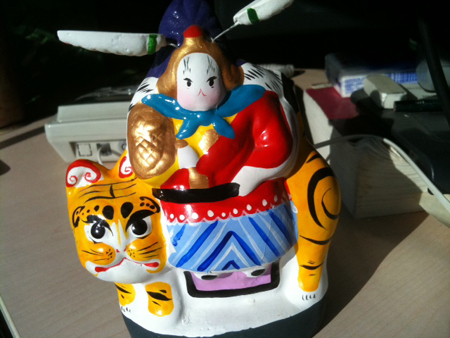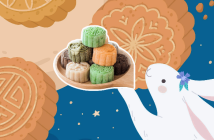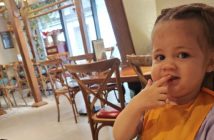
We’ve made it an annual New Year’s tradition to wander the grounds of Yonghegong and burn incense at the altars of the many Buddhas therein. Neither my wife (who is technically a Hui Muslim) nor I (of the “wait-and-see” camp) can claim to be Buddhists, but we very much consider visiting temples “a Chinese Thing” and go all out burning incense, buying amulets, bowing reverently – the whole nine yards.

Local tradition dictates that one should go and bai fo (艾佛) – make offerings to Buddha – during Spring Festival, but we’ve found out the hard way that visiting Yonghegong over Chun Jie is like shopping at Carrefour on Sundays – as Tony Soprano would say, fuggedaboutit.
So rather than mosh our way through Temple Fair Hell, we’ve been going on our annual Lama Temple visits in early January for the last couple of years, which has been made all the more meaningful because of our daughter’s birthday on the 12th.
Last weekend we stopped by Yonghegong armed with the customary packs of incense (RMB 10-30, depending on size) that we purchased at one of the many shops across the street from the main entrance. Most of the Buddhas here are standard-issue in temples across China, but the highlights, which include three exquisitely carved bronze Buddhas in the Hall of Harmony and Peace and the always impressive 26-meter tall white sandalwood statue of the Maitreya Buddha, are worth the RMB 25 admission (it’s free for kids under 5).
As with years past, I followed my wife’s lead and did the full circuit of the temple grounds, fastidiously bowing and offering incense in front of almost every Buddha in the place.

Much to the amusement of onlookers, our 3-year-old was also in on the bai fo action, bowing with unlit incense sticks clasped between her tiny hands at every altar in sight – a trick she learned during a trip to Shanxi in 2009.
It took us nearly an hour to get through the temple, with stops for a bathroom break and a look at the in-house Buddha sculpture exhibit along the way, and by noon we were starving. After exiting through the temple back onto Yonghegong Jie, we made a beeline for the first noodle joint (of which there are many along Yonghegong and Andingmennei Dajie) in sight.

Located about four doors down from Yonghegong’s main parking lot, The Terra Cotta Warriors Noodle Restaurant (Tai Yong Qi Shan Mian, 泰佣岐山面) is the kind of dingy dive you normally wouldn’t give a second glance, much less consider going inside to eat. We very nearly passed it up as well, but hunger and our achingly cold limbs compelled us to go inside.
Our gamble paid off. The yangrou pao mo (bits of lamb and bread served in a savory broth, 杨若泡沫) and rou jia mo (肉夹馍, essentially chopped meat and spices served in a round, flat bread) were completely satisfying, but the real star was the youpo chemian (油泼扯面), a “belt-like flat noodle popular throughout China’s northwest” – savory, thick and satisfyingly chewy, they came coated in just the right amount of oil, veg and meat and were the best I’ve had in Beijing.
We walked off lunch by strolling down Guozijian, stopping along the way in a couple of traditional toy shops where rabbits are definitely in season and Tu Ye (“Grandpa Rabbit” – 兔爷 – a mythical symbol of healing and protection for Beijing) figurines line the shelves.

Ranging in size, color and shape, these clay figurines are usually associated with the Mid-Autumn Festival but have taken on a special significance for the upcoming Year of the Rabbit. We picked out a small, palm-sized statue for RMB 20 and tucked him in Marianne’s pint-sized backpack, hoping that some more auspicious fortune would rub off on her for the coming year.



